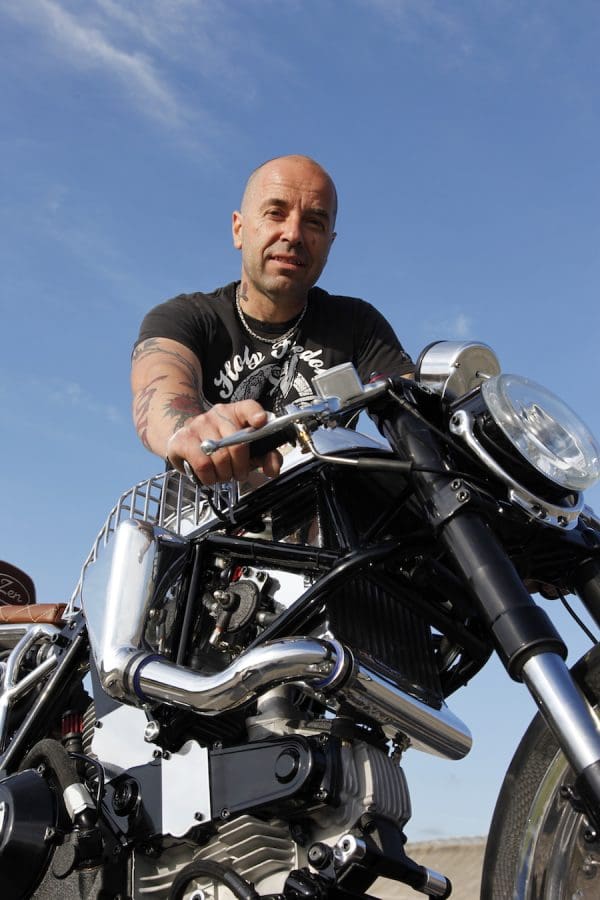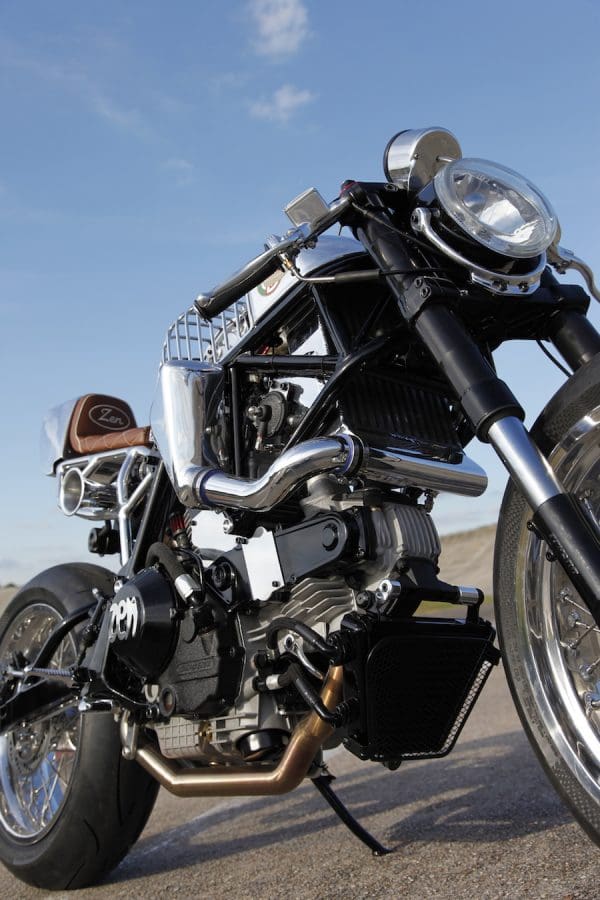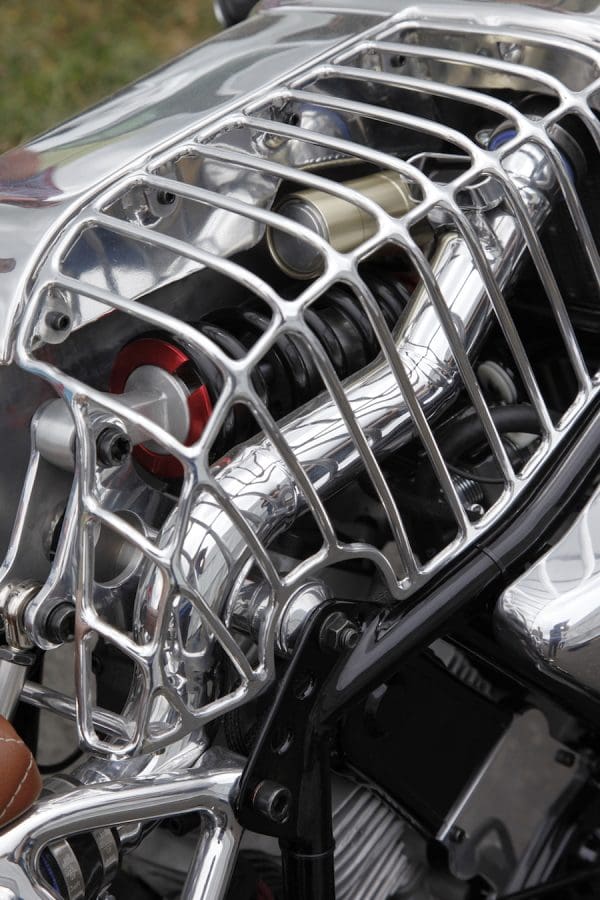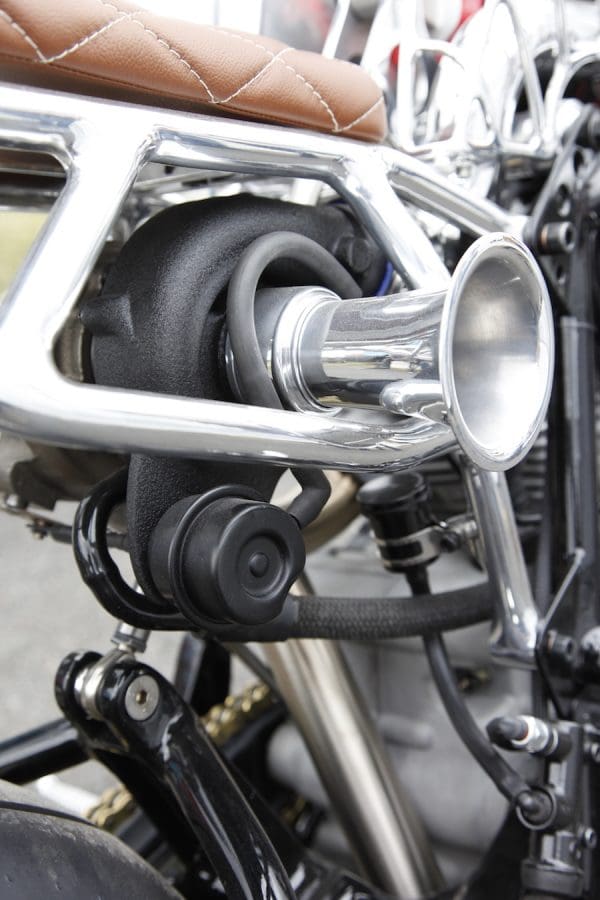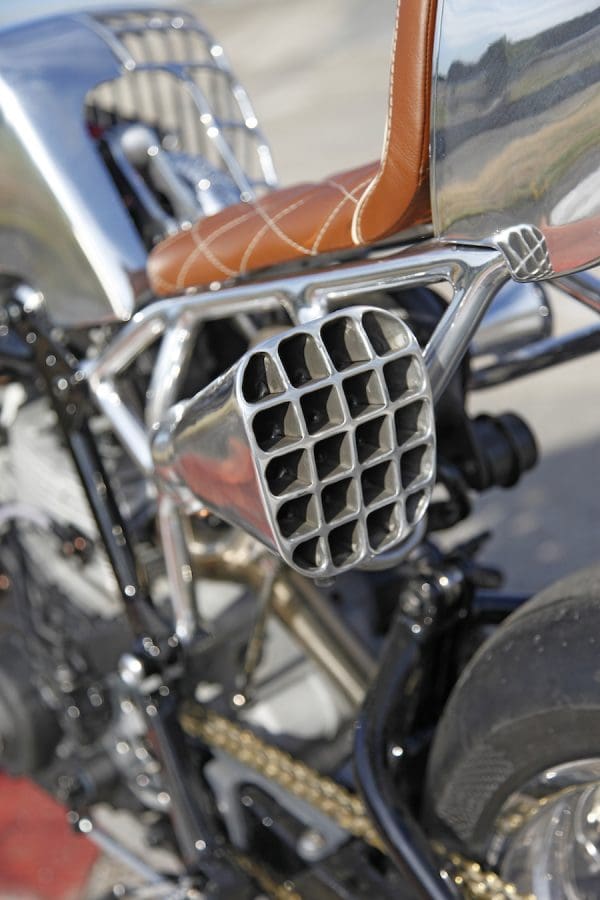Laurent Dutruel is wearing a smile a mile wide when he swoops off the Montlhéry banking and rolls to a stop. “Man, you’ve just got to try a V-twin turbo. There’s nothing like it!”
Nothing like a V-twin turbo? There’s nothing quite like the Zen Motorcycles’ 900SS. And there’s nobody quite like Laurent.
After working for 25 years in the family agricultural machinery business, the Frenchman needed a change. “I repaired a lot of lawn mowers – enough to last a lifetime,” he laughs. “So I became a mechanic at the Harley dealership in Nice.”
He wasn’t a big Harley fan, but they grew on him and it wasn’t long before he was building some impressive custom bikes – usually with a turbo to boost power. But never just for show. All Laurent’s bikes are made to perform as well as look cool. “I never lose sight of the fact that, for me, a motorcycle is built to be ridden,” he says, before adding: “And ridden hard.”
You can’t put Laurent in a box and label it ‘custom bike builder’. He built a rigid-framed, rigid-forked bike powered by a Buell XB9 engine that weighed only 115kg. There was no gearbox – only a countershaft to the clutch – and so to start the engine he wrapped a rope around a pulley on the mainshaft and yanked. “It starts easy. Just like a lawnmower!” says Laurent. In August 2011 he was timed at 208km/h on the Bonneville Salt Flats. “On a rigid bike the run was absolutely terrifying. But awesome!”
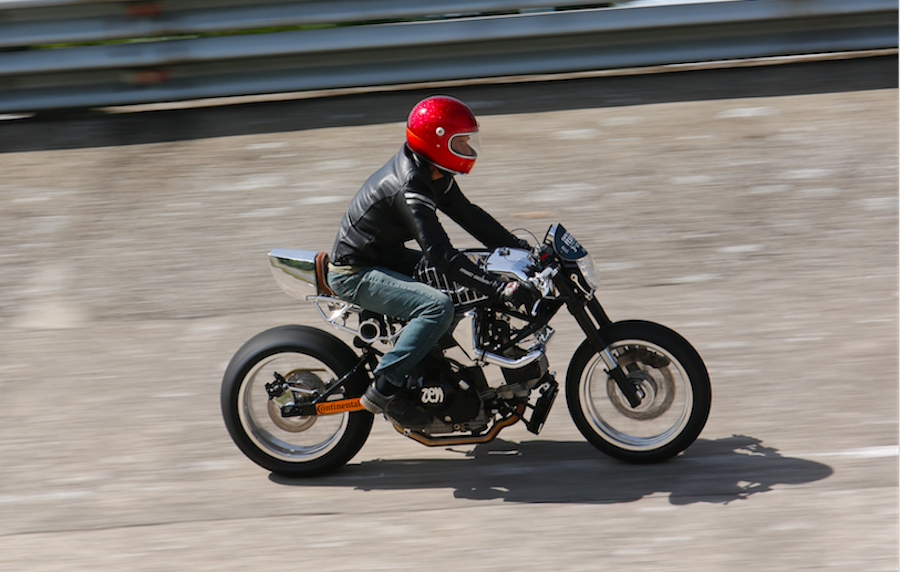
And then there was his turbocharged Harley XR1200S, which won the Street Performance class of the AMD custom bike world championship in 2013. He shipped that one to San Francisco and rode it cross-country to Bonneville, and then broke the record for the 1350 M-PBG class (Modified, Supercharged pushrod engine running on gasoline) with a speed of 255.265km/h.
Now based in Massongy on the south shore of Lake Geneva, Laurent calls his small business Zen Motorcycles. Of course, he’s still hooked on V-Twins. “There is something about the simplicity and purity of an air-cooled V-Twin that I find very attractive,” he explains. “And I also like turbochargers!”
While a supercharger is mechanically driven and starts to deliver its boost from low revs, a turbocharger is an air pump driven by the exhaust gasses. Whether you use a supercharger or a turbo, with more air in the combustion chamber more fuel can be burnt, which gives a bigger bang and more power.
A turbocharger is mechanically simple. It is basically two separate housings with a single shaft running through them, a bearing in the middle and a turbine fan at one end and a compressor fan at the other. The bearing that supports the shaft is sealed and lubricated by an oil feed from the engine – and that’s important, because you don’t want to contaminate the air with oil. Exhaust gasses from the combustion chamber spin the turbine before exiting through a hole in the turbine housing. The harder the engine revs, the more exhaust gasses are produced and the faster the turbine spins – maybe as fast as 200,000rpm. Yes, 200,000.
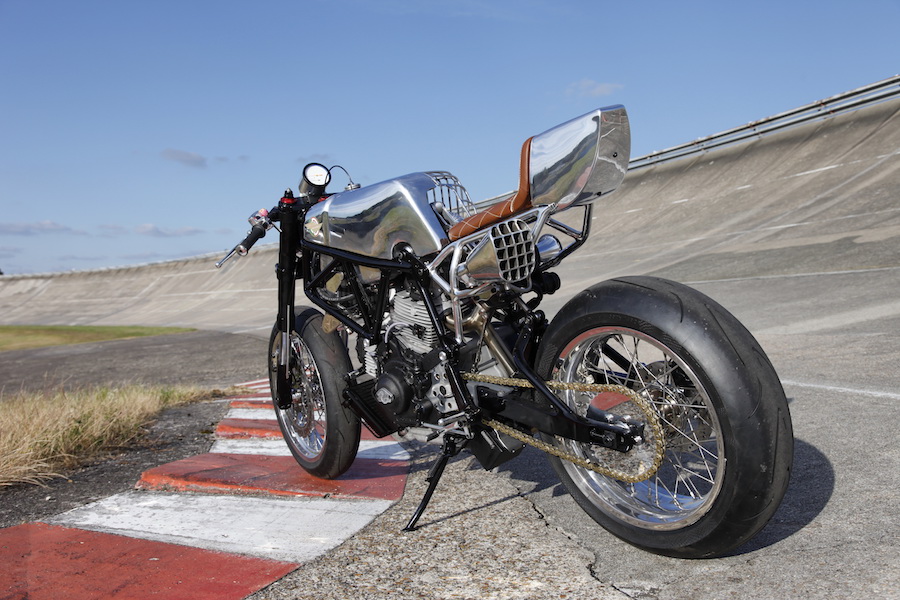
The compressor fan at the other end of the shaft lives inside a housing which is shaped like a snail shell. The turbo blows air into the shell, where it is compressed by the compressor fan. This compression heats the air, so it is pumped through an intercooler before being blown into the carburettor or fuel injection system and then to the combustion chamber. A turbo is a cheap way to get more power.
That’s where Laurent’s latest creation comes in. It started life as a 1995 Ducati 900SS, Bologna’s sweet-handling sports bike that delivers 55kW at the back wheel and a 210km/h top speed. He stripped off the fairing, tank and seat and got to work. “I decided that the best place for the turbo was behind the engine and under the seat. So I cut away the rear subframe, put the turbo in position, and then bent the stainless steel exhaust pipes to fit – the front one runs under the engine and up to the turbo, while the rear one is quite short.”
A turbo needs to spin at very high revs to be effective, and the ones used on motorcycles need to be small, so Laurent chose a Garrett GT2056. If he had used a four-cylinder engine he could have bolted it between the exhausts, intercooler and the carbs, and he would have been good to go. This is because a four-cylinder engine has an intake stroke every 180 degrees of crankshaft rotation, so there’s always an inlet valve open to a cylinder and the compressed air always has somewhere to go. And, because the exhaust strokes have the same spacing, the pulses are even and smaller, and drive the turbo at a constant (or steadily increasing) speed. But a V-Twin comes with its own special problems. Because of the large exhaust gas pulses and the intermittent intake strokes, sometimes there is nowhere for the turbocharged air to move to and it stagnates in the feed pipe. That’s why you need a plenum chamber – a box which stores the pumped air when the inlet valves were shut.
Laurent constructed a triangular plenum chamber from sheet alloy and mounted it between the V of the cylinders. “The volume of the plenum is important,” he explains. “Combined with the volume of the feed pipe, it needs to be five or six times the volume of a cylinder.” If you are wondering where he got that information, it comes courtesy of Honda. “That’s what they did with the CX500 Turbo, says Laurent. “I use one as my daily ride.”
Laurent wanted the intercooler to be as big as possible yet still fit under the petrol tank, behind the forks, so he bought a core from an American supplier and built one himself. While the 900SS used a pair of 38mm Mikuni carbs to feed the two-valve, SOHC Desmo, Laurent chose a single Mikuni HSR 45mm smoothbore. Of course, while a normally aspirated engine sucks air through the carburettor, a turbocharged engine has air blown through and so the Mikuni had to be modified. “It is not essential to have multi-carbs with a turbo,” he says. “One carburettor works just as well, it takes up less room, and it is much easier to tune.”
To avoid over-stressing a turbocharged engine, it is best to reduce the compression ratio. Instead of pistons with lower crowns, Laurent recommends fitting a thick alloy plate between the barrels and the crankcase. Now the Duke runs a compression ratio of 7.5:1, down from 9.2:1. “Don’t put the compression plate between the head and barrel,” advises Laurent. “You might get problems with combustion pressure blowing past it.”
With the turbo, intercooler and plenum chamber in place, it was obvious that the rear monoshock would have to be relocated. The
turbo was going to define the construction of this motorcycle. “I tried different ideas, but finally decided to lay the suspension unit on top of the engine and connect it to the swingarm through a bell crank,” says Laurent. Oh, and that meant modifying the original alloy swingarm by cutting off the upper box-section member that wraps around the tyre and replacing it with one made from round tube. A new rear subframe was constructed from a lattice of welded alloy tubes, while the polished alloy seat hump was designed to carry most of the electric components. “I don’t work from drawings,” says Laurent. “I just bend a piece of alloy sheet, and another, and then weld them together. Gradually the shape begins to take a form that I like, but not always – sometimes I have to start over again, and again, and again. I want my bike to be a perfect combination of beauty and rideability.”
That’s what happened with the petrol tank. “My first design covered the shock as well as the bell crank and the pipe from the turbo, but then I thought… why hide them? So I started again. Now the front and left side of the tank holds the fuel, but the right side is a lattice fabricated from alloy rods that have been welded together and polished to perfection. It lets you see the construction.” And that construction is rather special, with superb attention to detail. Check out the dinky Motogadget digital speedometer, which has been crafted onto the turbo pipe so that the rider has to peek between his knees to check how fast he’s going. “I put the turbo boost gauge where the speedometer is normally mounted,” adds Laurent. “It’s more important to see that than the speedo!”
It might seem a bit anal to keep re-making components, but you can tell that Laurent doesn’t take himself too seriously as soon as you see the ‘silencer’. “I call it the chip cutter,” he laughs. “You don’t really need a silencer if you have a turbo because the exhaust pulses have been absorbed and that cuts down the noise. But a motorcycle doesn’t look right if it doesn’t have a silencer, so I made this one.” He didn’t say if he melted down old chip pans to get the alloy to cast it…
To keep the Zen turbo Duke looking as clean as possible he has hidden most of the electric wiring inside the frame tubes, and the battery, slung under the back of the engine, uses the earth terminal to bolt it to the chassis. Not even the most passionate Ducatisti could claim that the 900SS has stylish wheels, so they were junked and replaced with alloy rims and stainless spokes. Laurent decided that he only needed a single disc up front. “It has enough stopping power and more feel, and looks a lot better as well!” He is making a pair of mudguards, rolling them to shape on an English wheel, but they weren’t finished in time for our test ride. He’s already clocked up 800 hours on the project. No wonder he was so keen to try it out on the Montlhéry banking.
Light weight and a turbocharged V-Twin make an awesome combination. You can choose as much boost and as much horsepower as you want. When the orange needle on the gauge indicates 0.7 bar the Ducati engine is delivering 90kW, but Laurent can play Dr Jekyll as well as Mr Hyde. “For most road conditions 0.4 bar is enough,” he says with a devilish grin that shows the temptation can sometimes be too much to resist. But which is more important, power or torque? “If you want to use a bike on the road, torque beats power every time,” says Laurent. “I love torque – not high revs!”
But don’t take his word for it.
Man, you’ve just got to try a V-twin turbo.

Report and photography Phillip Tooth
